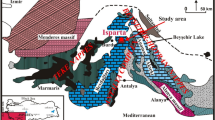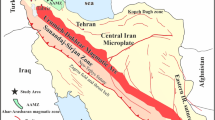Abstract
Potassium-rich volcanic rocks in the Isparta area (SW Turkey) consist mainly of older (Pliocene) volcanic rock suites (e.g., lamprophyre, basaltic trachyandesite, trachyandesite, trachyte) and younger (Quaternary) caldera forming lava dome/flows (e.g., tephriphonolite, trachyte) and pyroclastics (ash/pumice fall deposits and ignimbritic flows). The magnetic susceptibility (K) was performed for both groups. The magnetic susceptibility value of the less evolved rocks characterized by SiO2 < 57 wt% (e.g., basaltic trachyandesite, tephriphonolite, lamprophyric rocks) and having mostly mafic phenocrysts such as pyroxene, amphibole, and biotite-phlogopite is over 10 (10−3 [SI]). Fine to medium-grained and subhedral to anhedral opaque minerals are scattered especially in the matrix phase of the less evolved volcanic rocks. However, the K value of the more evolved rocks (e.g., trachyte and trachyandesites) with SiO2 over 57 wt% vary between 0.1 and 28, but most of them below 10. SI values are negatively correlated with SiO2, Na2O, but positively correlated with Fe2O3, CaO, MnO, P2O5 and MgO contents, suggesting inverse variation of SI with fractionation of potassic magma. That is to say that less evolved volcanic rocks have relatively higher magnetic susceptibility values in the volcanic suite. Fine to medium-grained and subhedral to anhedral Fe-Ti oxides are scattered mainly in the matrix phase of the less evolved volcanics, presumably cause the pronounced relatively higher magnetic susceptibility.
Similar content being viewed by others
References
Aydın A, Feré E C and Aslan Z 2007 The magnetic susceptibility of granitic rocks as a proxy for geochemical composition: Example from the Saruhan granitods, NE Turkey; Tecotonophys. 441 85–95.
Balsley J R and Buddington A F 1960 Magnetic susceptibility anisotropy and fabric of some Adirondack Granites and orthogneisses; Am. J. Sci. Bradley 258-A 6–20.
Borradaile G, Mothersill J, Tarling D and Alford C 1986 Sources of magnetic susceptibility in a slate; Earth Planet. Sci. Lett. 76 336–340.
Elitok Ö, Özgür N, Drüppel K, Dilek Y, Platevoet B, Guillou H, Poisson A, Scaillet, S, Satır M, Siebel W, Bardintzeff J-M, Deniel C and Yılmaz K 2010 Origin and geodynamic evolution of late Cenozoic potassiumrich volcanism in the Isparta area, southwestern Turkey; Int. Geol. Rev. 52(4–6) 454–504.
Geuna S E, McEnroe S A, Robinson P and Escosteguy L D 2008 Magnetic petrology of the Devonian Achala Batholith, Argentina: Titanohaematite as an indicator of highly oxidized magma during crystallization and cooling; Geophys. J. Int. 175 925–941.
Grégoire V, Darrozes J, Gaillot P and Nédélec A 1998 Magnetite grain shape fabric and distribution anisotropy vs. rock magnetic fabric: A three-dimensional case study; J. Struct. Geol. 20(7) 937–944.
Henry B, Jordanova D, Jordanova N, Souque C and Robion P 2003 Anisotropy of magnetic susceptibility of heated rocks; Tectonophys. 366 241–258.
Hunt C P, Moskowitz B M and Banerjee S K 1995 Magnetic properties of rocks and minerals; Rock Physics and Phase Relations, A Handbook of Physical Constants, AGU Reference Shelf 3.
Kumral K, ÇOban H, Gedikoğlu A and Kılınç A 2006 Petrology and geochemistry of augite trachytes and porphyritic trachytes from the Gölcük volcanic region, Isparta, SW Turkey: A case study; J. Asian Earth Sci. 27 707–716.
Lanza R and Meloni A 2006 The Earth’s Magnetism — An Introduction for Geologists (Berlin Heidelberg: Springer-Verlag), 267 p.
Le Bas M J, Le Maitre R W, Streckeisen A and Zanettin B 1986 A chemical classification of volcanic rocks based on the total alkali-silica diagram; J. Petrol. 27(3) 745–750.
Nakamura N and Borradaile G J 2004 Metamorphic control of magnetic susceptibility and magnetic fabrics: A 3-D projection; In: Magnetic Fabric Methods and Applications (eds) Martin-Hernandez F, Lüneburg C M, Aubourg C and Jackson M, Geol. Soc. London Spec. Publ. 238 61–68.
Natland J H 2002 Magnetic susceptibility as an index of the lithology and composition of gabbros, ODP Leg 176, Hole 735B, Southwest Indian Ridge; In: Natland J H, Dick H J B, Miller D J and Von Herzen R P (eds); Proc. ODP, Sci. Results 176 1–69.
Nishioka I, Funaki M and Sekine T 2007 Shock-induced anisotropy of magnetic susceptibility: Impact experiment on basaltic andesite; Earth Planets Space 59 e45–e48.
Oniku S A, Osazuwa I B and Meludu O C 2008 Preliminary report on magnetic susceptibility measurements on rocks within the Zaria granite batholith, Nigeria; Geofizika 25(2) 203–213.
Platevoet B, Scaillet S, Guillou H, Blamart D, Nomade S, Massault M, Poisson A, Elitok ö, özgür N, Yağmurlu F and Yılmaz K 2008 Pleistocene eruptive chronology of the Gölcük volcano, Isparta Angle, Turkey; Quaternaire 19(2) 147–156.
Searle R C 2008 Magnetic susceptibility as a tool for investigating igneous rocks — experience from IODP Expedition 304; Scientific Drilling 6 52–54, doi:10.2204/iodp.sd.6.08.2008.
Thomson R and Oldfield F 1986 Environmental Magnetism (London: Allen and Unwin) 220 p.
Verosub K L and Roberts A P 1995 Environmental magnetism: Past, present and future; J. Geophys. Res. 100 2175–2192.
Author information
Authors and Affiliations
Corresponding author
Rights and permissions
About this article
Cite this article
Elitok, Ö., Kamaci, Z., Nuri Dolmaz, M. et al. Relationship between chemical composition and magnetic susceptibility in the alkaline volcanics from the Isparta area, SW Turkey. J Earth Syst Sci 119, 853–860 (2010). https://doi.org/10.1007/s12040-010-0054-1
Received:
Revised:
Accepted:
Published:
Issue Date:
DOI: https://doi.org/10.1007/s12040-010-0054-1




